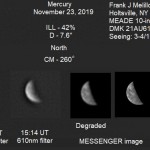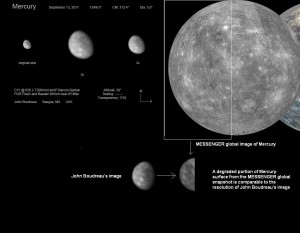April 11, 2022
Mercury Observing Watch on April 23, 2022
Those of you who received the April 2022 issue of Astronomy might have noticed the article, “The Strange History of Mercury's Spot” on p. 52. William Sheehan wrote the bulk of the story for which I provided him with some information. The Italian astronomer Giovanni Schiaparelli was renowned for seeing the canals on Mars, but he was also known for seeing odd markings on Mercury. He made a famous drawing on February 6, 1882, in which he recorded shading on the planet’s disk that resembled the number ‘5'. Nothing was confirmed at that time, so it was kind of sketchy.
As it turns out, on the upcoming evening of April 23rd, Mercury will be nearly in the same exact position where Schiaparelli saw the number '5' figure in the evening sky. As noted on the right side of p. 55 (and pointed out in my communication for the article), Mercury will display the same part of the surface, the same phase angle, and the same apparent disk diameter as when Schiaparelli made his sketch. So hopefully, that evening, you will have an opportunity to duplicate Schiaparelli's observation and see if you can make out the number '5' figure on the disk. With today's optics, you can probably succeed in capturing it if the seeing conditions allow.
Please be sure to send the observations, whether you see the marking or not, to the ALPO at mercury@alpo-astronomy.org.
November 24, 2019
Favorable Mercury apparition
Mercury is having its best morning apparition of the year. First, we all knew that it started when Mercury crossed the face of the sun on November 11th which is known as the Transit. It became quickly as a morning object before sunrise. Due to the ecliptic angle which is very steep this time of the year, Mercury stands already high in the morning twilight. It will approach the greatest elongation on November 28th about 20 degrees west of the sun.
I already took my first images on November 23rd and it shows a fat crescent. There is a suspicious white region on the north side near the cusp and most likely it is a rayed crater according the MESSENGER image. During the coming days, two more features will be visible in the southern hemisphere. They are Ellington and Debussy which are the two most prominent ray craters visible from earth. Mercury’ phase will approach half to gibbous during the first week of December and most of the surface will be exposed. Much more details can be seen at this time.
Please take advantage of observing and imaging Mercury while it is the best morning apparition of the year and the most prominent features of the surface will be facing us.

How to submit Images/Observations for inclusion in the ALPO Galleries
ALPO’s archives go back many years and preserve the many observations and reports made by amateur astronomers. ALPO’s galleries allow you to see on-line the thumbnail images of the submitted pictures/observations, as well as full size versions. It now is as simple as sending an email to include your images in the archives. Simply attach the image to an email addressed to the following email address and the image will be included:
mercury@alpo-astronomy.org
Please make sure the filename of the image complies with the filename convention for our gallery:
WinJUPOS-Conventon
“YYYY-MM-DD-HHMM[.T]-Observer[-Image info].” (brackets “[ ]” indicate optional fields)
YYYY {0..9} Year
MM {0..9} Month
DD {0..9} Day
HH {0..9} Hour (UT)
MM {0..9} Minute (UT).
.T {0..9} tenth of minute, the “.” translates to an “_” in the gallery (Optional)
Observer {Text} Initials
Image info {Text} Additional info (Optional) (NO spaces or special characters other than “_” or “-”)
The observer info should be in an abbreviated form (e.g. initials of first and last name).
As an example the following file name would be a valid filename: 2018-04-25-0916-JC-Ha-AR2706
(Year 2018, Month 04, Day 25, UT Time 0916, JC abbreviation for observer Jeffrey Carels, Hydrogen Alpha filter, Active Region AR2706)
If the filename does not conform to the standard, the staff member to upload the image into the data base will make the correction prior to uploading the image(s). However, if they come in the recommended format, it would reduce the effort to post the images a lot.
Observers who submit drawings should scan their images at a resolution of 72 dpi and save the file as a 8 1/2′ x 11″ or A4 sized picture.
Finally a word to the type and size of the submitted images. It is recommended that the image type of the file submitted is a jpg. The only other file type acceptable is a png. The file size should not exceed 200kB-300kB. Details are well preserved in images of much smaller files. Please use compression (quality) settings to achieve these file sizes.
March 3, 2012
2011 Mercury Observations Posted
Please follow this link to see 2011 Mercury observations.
January 28, 2012
Remarkable Mercury Image by John Boudreau
“I thought you would to post this on the ALPO website. Mr. John Boudreaus’ image is just incredible and it is easily comparable with the MESSENGER’s view.
Thanks,
Frank J Melillo”
.
.
January 22, 2011
Mercury Observations 2010
Mercury observations for 2010 have been posted.
Observations 2016-2008
Earlier Observations
http://alpo-astronomy.org





